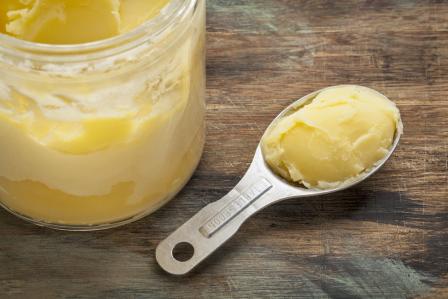All About Ghee
What is ghee, how do you use it, and is it a good choice nutritionally? Find out.
Monica Reinagel, MS, LD/N, CNS

Question. “Can you explain what ghee is and whether it’s good or bad for us?”
Answer. Ghee is a Sanskrit word for a food that is very similar to what Western chefs call clarified butter. A lot of people are surprised to learn that butter is not 100% fat. It also contains a fair amount of water and some milk solids, which are a combination of protein and carbohydrates. Clarified butter (or ghee) is made by heating butter until the water evaporates and the milk solids separate out. The resulting product is much closer to 100% fat. It also has a higher smoke point and a longer shelf life. Because all the milk proteins and sugars have been removed, clarified butter is also acceptable for people with lactose intolerance and milk allergies.
Heating the butter doesn’t change the composition of the fat. Clarified butter is about two-thirds saturated fat and one-quarter monounsaturated fat, with a little bit of polyunsaturated fat making up the difference. If you have room for butter in your diet (and I certainly do in mine!) then ghee should pose no concern.
See also: Is the Link Between Cholesterol and Heart Disease Bogus? and How Much Fat Should You Eat?
Because of its high smoke point and low percentage of polyunsaturated fat, ghee is an excellent choice for high-heat cooking.
See also: Which Oils Are Best For Cooking?
Ghee is traditionally made from cow’s milk but I’ve seen ghee made from sheep and goat milk as well. Just steer clear of anything labeled “vegetable ghee,” which is usually made from hydrogenated vegetable oils.
See also: What Are Trans Fats Being Replaced With?
Ghee image courtesy of Shutterstock.

